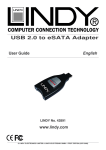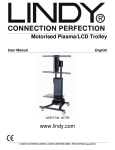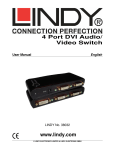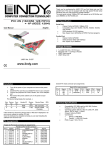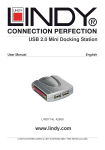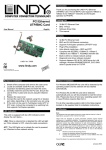Download Lindy 42865
Transcript
USB 2.0 & eSATA HDD Docking Station Hardware Introduction Thank you for purchasing the LINDY USB 2.0 & eSATA HDD Docking Station. Now you have the convenience and speed of connecting 2.5” or 3.5” SATA hard drives to your USB or eSATA enabled computer without the need for a complicated drive housing. 1. 2. 3. 4. 5. SATA Interface Eject Button 2.5” Drive Slot 3.5” Drive Slot Power & Activity LED Installation Features • • • • • • Supports all 2.5” and 3.5” SATA I/II hard drives High Speed eSATA 3Gbps and USB 2.0 480Mbps interfaces Hot Swapping for quick drive exchanges Plug and Play installation Eject button for safe removal of your hard drive Compatibility: Windows 2000/XP/Vista & Mac OS 10.3 or later Package Contents • • • • • USB 2.0 & eSATA HDD Docking Station eSATA Cable USB Cable Power Supply This manual 1. Connect the USB or eSATA cable to the matching port on the back of the docking station and your computer 2. Connect the power cable to the back of the docking station and to the mains power supply 3. Firmly insert your SATA Hard Drive face down with the connectors aligned to the SATA interface 4. Turn on the Docking Station using the power switch 5. No driver is required; allow your computer to detect and install the Docking Station 6. Once your computer has finished installing the Docking station it is ready to use Disk Ejection 1. Ensure that the Power and Activity light is not flickering and that no data transfer is in place 2. Firmly press down on the Eject button 3. The Hard Drive will be ejected from the SATA connection and may now be removed. © LINDY ELECTRONICS LIMITED & LINDY-ELEKTRONIK GMBH - FIRST EDITION (July 2008) CE Certification This equipment complies with the requirements relating to electromagnetic compatibility, EN 55024 and EN55022 class A for ITE, EN61000-3-2/-3 the essential protection requirement of Council Directive 89/336/EEC on the approximation of the laws of the Member States relating to electromagnetic compatibility. Shielded cables must be used with this equipment to maintain compliance with radio frequency energy emission regulations and ensure a suitably high level of immunity to electromagnetic disturbances. FCC Warning This equipment has been tested and found to comply with the limits for a Class B digital device, pursuant to part 15 of the FCC Rules. These limits are designed to provide reasonable protection against harmful interference in a residential installation. This equipment generates, uses, and can radiate radio frequency energy and, if not installed and used in accordance with the instructions, may cause harmful interference to radio communications. However, there is no guarantee that interference will not occur in a particular installation. If this equipment does cause harmful interference to radio or television reception, which can be determined by turning the equipment off and on, the user is encouraged to try to correct the interference by one or more of the following measures: Reorient or relocate the receiving antenna Increase the separation between the equipment and receiver Connect the equipment into an outlet on a circuit different from that to which the receiver is connected Consult the dealer or an experienced technician for help You are cautioned that changes or modification not expressly approved by the party responsible for compliance could void your authority to operate the equipment. This device complies with part 15 of the FCC Rules. Operation is subject to the following two conditions: 1. This device may not cause harmful interference, and 2. This device must accept any interference received, including interference that may cause undesired operation. LINDY No 42865 st 1 Edition, July 2008 www.lindy.com WEEE (Waste of Electrical Recycling of Electronic Products and Electronic Equipment), United Kingdom In 2006 the European Union introduced regulations (WEEE) for the collection and recycling of all waste electrical and electronic equipment. It is no longer allowable to simply throw away electrical and electronic equipment. Instead, these products must enter the recycling process. Each individual EU member state has implemented the WEEE regulations into national law in slightly different ways. Please follow your national law when you want to dispose of any electrical or electronic products. More details can be obtained from your national WEEE recycling agency. Germany / Deutschland Die Europäische Union hat mit der WEEE Direktive umfassende Regelungen für die Verschrottung und das Recycling von Elektro- und Elektronikprodukten geschaffen. Diese wurden von der Bundesregierung im Elektro- und Elektronikgerätegesetz – ElektroG in deutsches Recht umgesetzt. Dieses Gesetz verbietet vom 24.März 2006 an das Entsorgen von entsprechenden, auch alten, Elektro- und Elektronikgeräten über die Hausmülltonne! Diese Geräte müssen den lokalen Sammelsystemen bzw. örtlichen Sammelstellen zugeführt werden! Dort werden sie kostenlos entgegen genommen. Die Kosten für den weiteren Recyclingprozess übernimmt die Gesamtheit der Gerätehersteller. France En 2006, l'union Européenne a introduit la nouvelle réglementation (DEEE) pour le recyclage de tout équipement électrique et électronique. Chaque Etat membre de l’ Union Européenne a mis en application la nouvelle réglementation DEEE de manières légèrement différentes. Veuillez suivre le décret d’application correspondant à l’élimination des déchets électriques ou électroniques de votre pays. Italy Nel 2006 l’unione europea ha introdotto regolamentazioni (WEEE) per la raccolta e il riciclo di apparecchi elettrici ed elettronici. Non è più consentito semplicemente gettare queste apparecchiature, devono essere riciclate. Ogni stato membro dell’ EU ha tramutato le direttive WEEE in leggi statali in varie misure. Fare riferimento alle leggi del proprio Stato quando si dispone di un apparecchio elettrico o elettronico. Per ulteriori dettagli fare riferimento alla direttiva WEEE sul riciclaggio del proprio Stato.


